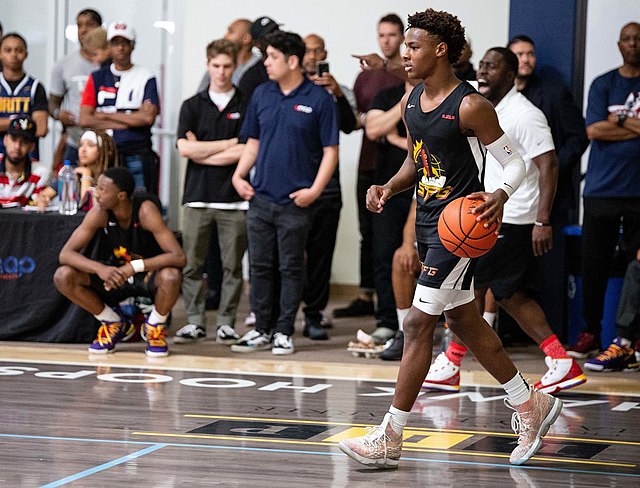
By
Bronny James, the eldest son of NBA champion Lebron James, suffered cardiac arrest during basketball practice at the University of Southern California on Monday.
According to a statement from the James family — posted on social media by Shams Charania, the senior NBA insider for The Athletic — the 18-year-old point guard has been released from intensive care in stable condition.
“We ask for respect and privacy for the James family and we will update media when there is more information,” the statement said. “LeBron and Savannah wish to publicly send their deepest thanks and appreciation to the USC medical and athletic staff for their incredible work and dedication to the safety of their athletes.”
Bronny committed to USC earlier this year after a career at Los Angeles’ Sierra Canyon High School, where he helped lead the basketball team to the Mission League title.
The six-foot-three, four-star recruit averaged 13.8 points, 5.5 rebounds, 2.7 assists, and 1.8 steals during his senior year, according to the Los Angeles Times’ Luca Evans.
After committing to USC, his dad wrote on his Instagram, “So damn proud of you kid! I have no words besides I LOVE YOU!!!”
As James enters his 21st season in the NBA, one of his final goals is for “my last year to be played with my son,” he told The Athletic in 2022.
What happens during cardiac arrest?
Bronny’s health scare came one year after another USC player, Vincent Iwuchuckwu suffered a cardiac arrest during a team workout.
“I just got super dizzy out of nowhere…and bam. That’s all I remember,” Iwuchuckwu said in a video. “It felt like it was a dark void.”
The seven-foot-one forward initially considered hanging up his jersey and “focusing on school.” But after tears and reflection, he pursued physical therapy in hopes of a comeback.
“I have so much respect for that orange ball that I’m willing to take whatever recovery road I have to to come back and play,” he said.
What James and Iwuchuckwu experienced is a life-threatening medical emergency. When a cardiac arrest happens, the heart stops beating and blood stops flowing to the brain and other organs. This can cause loss of consciousness or disability.
Cardiac arrest is different from heart attack, where the heart continues to beat while an artery is blocked from supplying blood to its tissue, causing a lack of oxygen, death of heart cells, and symptoms like chest pain.
Both require immediate treatment to prevent fatality.
In the United States, every three days, on average, a competitive athlete experiences a sudden cardiac death, according to a 2012 study by Tufts University School of Medicine.
In addition, a 2016 study by University of Washington researchers found that among NCCA athletes, the risk for cardiac arrest “among male Division 1 basketball players has been estimated at more than 10 times that in the overall athlete population.” And, an increased risk of cardiac arrest has been found with Black male basketball players. The reason for this increased risk is unclear to researchers.
Fortunately, James and Iwuchuckwu received immediate medical attention from staff — as did Damar Hamlin of the NFL Buffalo Bills, who suffered a cardiac arrest in January during a “Monday Night Football” game. He was hospitalized for over a week following the incident.
With news of Bronny’s emergency, Hamlin extended support to the James family on Twitter.
“Prayers to Bronny & The James family as well,” he wrote on Tuesday. “Here for you guys just like you have been for me my entire process.”


